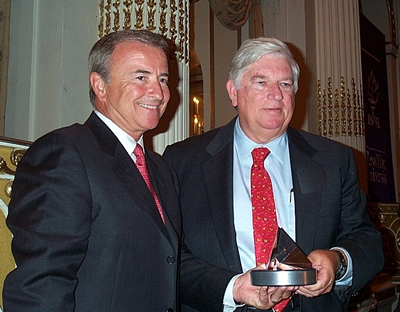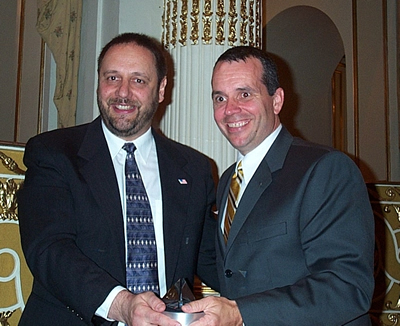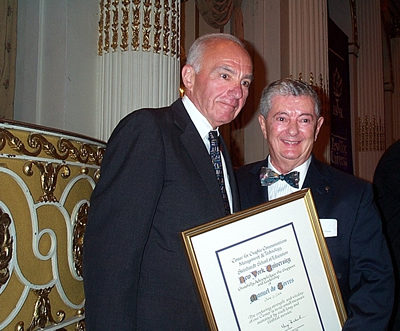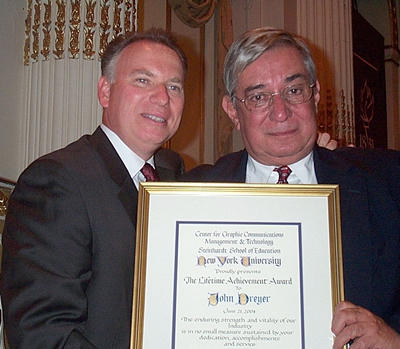Fill a ballroom in one of New York City’s most famous hotels with 500 of the metro area’s most prominent printing and publishing executives, and what you have is a one-of-a-kind event known as the Prism Award Luncheon. It’s an annual affair that pays tribute to the some of the industry’s most formidable figures, but it’s about more than heaping extra recognition on those whose profiles scarcely could be higher.
 |
| Thomas A. Quadracci (left), President and CEO of Quad/Graphics, presents the 2004 Prism Award to Don Logan, Chairman of the Media & Communications Group of Time Warner. |
The Prism Award Luncheon also is a fundraiser for the industry’s academic lighthouse at New York University, the Center for Graphic Communications Management and Technology. For 19 years, the event has been a powerful magnet for money in support of the Center, a graduate and post-graduate facility that trains intellectually ambitious members of the industry for managerial leadership.
 |
|
Bruce L. Myers (right), who earned his doctorate from the Center for Graphic Communications Management and Technology this year, receives the Student Prism Award from Gregory S. D’Amico, the Center’s director. Myers thanked his employer, X-Rite, for encouraging his studies. D’Amico, who will be leaving the Center to accept a tenured position within the State University of New Jersey, received a certificate of appreciation from the Center’s grateful advisory board. |
At the Plaza Hotel on June 21, facing a sea of tables so densely packed that the waiters barely had room to serve, luncheon co-chair Jeff Jacobson (Kodak Polychrome Graphics) announced that this year’s Prism fete had raised a record $260,000, “the vast majority of which goes to scholarships.” The draw for the expensive seats was what it always is: the opportunity to salute high-ranking industry figures not only for supporting the Center, but for pursuing careers of exemplary achievement that have inspired others to aim as high.
The Prism Award is a seven-faceted crystal meant to symbolize excellence in art, communication, leadership, graphic design, technological innovation, service, and freedom of expression. A student version of the award is presented to a Center graduate with an exceptional record of academic accomplishment.
Don Logan, Chairman of Time Warner’s Media and Communications Group, embodied the tradition in his receipt of the 2004 Prism Award, one of several honors presented during the ceremony (see photographs). He was introduced by Thomas A. Quadracci, President and CEO of Quad/Graphics.
In his acceptance remarks, Logan said the recession that had long gripped the industry finally was ending. “We’re coming out of it now,” he told the crowd. “As long as the economy holds, print is on the way back.”
 |
|
The Prism ceremony included the presentation of a Distinguished Service Award to Manuel De Torres (right), CEO of Metro Packaging & Imaging. Arnold Spinner, a former director of the Center, praised De Torres as one of the institution’s founding members and as the person responsible for setting up its original facilities. |
Logan bluntly addressed several issues that he described as obstacles to a full recovery for printed publications. One was the increasingly high cost of acquiring and retaining subscribers, a potential threat to preserving advertising rate bases. Another was what he called the “maniacal business” of newsstand distribution, in which, Logan contended, “we throw away more copies than we sell.”
He also called for reform of the postal system, and he pilloried magazine publishers for being “the worst in any industry” when it came to the delay between taking a customer’s order for a product and actually delivering it—the often weeks-long wait that separates requesting a magazine subscription from receiving the first copy.
 |
|
Calling him “one of the most recognizable personalities in this industry,” Jeff Jacobson (left), chairman of the Center’s advisory board, presented a Lifetime Achievement Award to John Dreyer, the retired Chairman of Pitman Co. Now a consultant marking his 50th anniversary in printing, Dreyer led what continues to be a leading distributor of printing and imaging supplies. He recalled the bygone techniques and processes of 1954—the year he entered the industry as a 14 year old boy whose duties included sweeping the floor of a trade shop. “Today,” Dreyer observed, “sweeping the floors is the only thing left.” |
But despite all of his criticisms, Logan professed faith in the magazine business and said that Time Warner would expand its portfolio of periodicals. He said plans include the launch of new magazines, acquisitions of existing titles, and the reincarnation of Life magazine as a newspaper supplement. “We’ll put our money where our mouth is,” Logan said.
Like Logan, other speakers urged the audience to keep faith with their medium and to uphold the values endorsed by the Prism Award. “Be forthright in your passion for the industry,” declared Jacobson, chairman of the Center’s advisory board.
The Center for Graphic Communications Management and Technology was organized in 1980 by executives who wanted to found an institution of higher learning with study programs specific to graphic communications. The 47 members of its advisory board represent a broad cross-section of leading printers, publishers, suppliers, technology developers, and media organizations.
The Center is a part of the Department of Culture and Communications in NYU’s Steinhardt School of Education. Offering undergraduate, master’s, and doctoral degrees, the Center aims to provide a conceptual and critical foundation in graphic communications while keeping abreast of the latest advances in theory and technology. Its faculty are drawn from the University and from a wide assortment of graphic communications businesses.














